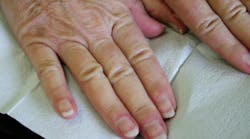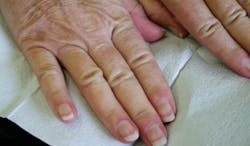by NANCY W. BURKHART, BSDH, EdD
Your patient today is a 56-year-old female, Cheryl, and she is a new patient. You are curious about the fact that it is summer and she is wearing winter gloves. As you complete your exam with Cheryl, you learn that Raynaud's phenomenon has troubled her for a few years, and she has learned to take the necessary protocol to try and keep the effects at a minimum level. As she begins to tell you about the disorder and her particular problems, you learn even more about this strange phenomenon called Raynaud's phenomenon.
Although Raynaud's phenomenon may affect other areas of the body such as the toes, ears, the nipples in breast-feeding women, and the nose, the fingers are the most commonly affected body part. Small arterioles in the fingers are affected and the circulation of the blood is reduced because of constriction of the vessels. The entity of Raynaud's phenomenon has been described as episodic, a digital ischemic vasospasm triggered by cold or emotional stress.
The occurrence of Raynaud's phenomenon is reported in three to four percent of the general population. In the image provided, the most striking feature is the redness that is produced within the fingertips. A characteristic pallor associated with vasospasms is a feature of Raynaud's phenomenon, and this white color supersedes the redness that appears as blood flow returns to normal. Initially the tissue is pale white, then cyanotic, and ultimately becoming red in color. The patient experiences pain, numbness, or tingling and discoloration of the fingers. The tips of the fingers feel very cold, and the gloves help to warm the fingers in an attempt to prevent the Raynaud's from occurring initially. In rare cases, necrosis of the fingertips may occur.
Raynaud's is a factor in some autoimmune diseases. Since higher rates of women are diagnosed with autoimmune diseases, the statistics indicate that cases of Raynaud's are generally higher in women.
The patient presented in this case study did report the presence of scleroderma that had existed for approximately 10 years. Wearing gloves has become part of her attire, and Cheryl wears them even in the summer months. The air conditioning during summer months causes the cold sensation in the fingertips and the numbness.
Raynaud's phenomenon is associated with connective tissue diseases such as lupus erythematosus, scleroderma, and rheumatoid arthritis and may be classified as primary or secondary. Those associated with connective type disorders are in the category of secondary Raynaud's phenomenon. It is thought that the phenomenon is due to endothelial dysfunction. Abnormal spasms caused by the nerves controlling blood flow cause a diminished blood supply to the tissues producing the blanched (white) appearance. The tissue then becomes cyanotic with a blue cast because of the lack of blood flow. When the blood vessels reopen, the flow is rushed to the area and produces the red color. The cause of primary Raynaud's not associated with these disease states is even more vague at this time and the pathophysiological mechanisms are not clearly understood.
The phenomenon may also be caused by past trauma such as frostbite or occupational traumas such as carpal tunnel syndrome and other repetitive stress disorders. Tools that vibrate have been noted as causing onset.
Recent studies (Donmez, et al. 2012) found that fibromyalgia patients who had Raynaud's syndrome demonstrated higher anxiety, depression, somatic syndrome, and high neuropathic pain scores than others within the group. Stress has been previously noted as a component in the development of Raynaud's phenomenon. Because of the association with stress, the introduction of some lifestyle interventions may prove successful for many patients.
Lifestyle interventions offer the most promising treatment modalities in dealing with Raynaud associated symptoms as well. The treatment of the underlying autoimmune diseases, discontinuation of vasoconstrictive medications (when possible), and careful attention to the change in temperature of the body appear to be the major considerations in controlling Raynaud's phenomenon. Some medications such as calcium channel blockers promote relaxation of vascular smooth muscles leading to vasodilatation. In patients with CREST syndrome, calcium channel blockers may cause sphincter tone reduction in the lower esophagus. The use of these medications may result in additional problems for the patient, but may be needed in some cases. Simple procedures such as wearing jewelry that is not too tight guard against constriction of blood flow, wearing shoes that are not too confining and using gloves while washing dishes or in contact with cold foods are some recommended suggestions.
Dr. Andrew Weil suggests several techniques to assist the patient who presents with Raynaud's syndrome:
- Running warm water over the hands and feet during attacks.
- Relaxed breathing to help relax the entire autonomic nervous system. Visit www.drweil.com for a demonstration of the breathing technique.
- Stress reduction to reduce the number of episodes.
- Acupuncture may assist and decrease the attacks.
- Niacin-B3, (100 mg/twice a day).
- Ginkgo biloba to increase circulation in the fingertips. The dosage is 120 to 240 mg per day.
- Biofeedback and self-hypnosis. Biofeedback works to teach the patient to bring warmness to the fingertips. Many medical, pain control facilities, etc., offer these techniques and this may be optimal for the patient who has severe problems with Raynaud's phenomenon.
- Smoking cessation. Smoking causes constriction of blood vessels.
- Caffeine reduction or elimination.
- Dressing warmly to avoid the symptoms associated with Raynaud's and to prevent episodes.
The actual autoimmune disease and any treatments rendered will also contribute to Raynaud frequency as well. Patients report that Raynaud's is elevated during periods of exacerbation of the autoimmune disease. Medications may be prescribed in severe cases but usually have side effects that need to be considered both for the autoimmune disease and for the Raynaud symptoms as well.
The dental community may be instrumental in detecting autoimmune type diseases associated with Raynaud's phenomenon even before the confirmation of the autoimmune disease itself. "Paying attention" to the external clues that the body presents is crucial in disease recognition. Suggestions for the patient may actually come from the dental office since the patient is most likely to be seen even more often by their dental professional than by their physician.
As always, keep asking good questions and always listen to your patients. RDH
References
Burkhart NW. Scleroderma, http://www.rdhmag.com/articles/print/volume-29/issue-6/columns/oral-exams/scleroderma.html
Brown S. Diagnosis and management of patients with Raynaud's phenomenon. Nurs Stand. 2012: Jul 18-24: 26(46): 41-6.
Donmez S. Pamuk On, Umit EG, Top MS. Autoimmune rheumatic disease associated symptoms in fibromyalgia patients and their influence on anxiety, depression and somatisation: a comparative study. Clin Exp Rheumatol Nov, 2012.
DeLong L, Burkhart NW. General and Oral Pathology for The Dental Hygienist. Lippincott, Williams & Wilkins. Baltimore. 2008.
Weil, A. Raynaud's phenomenon. http://www.drweil.com/drw/u/ART00402/Raynauds-Disease.html?print=1
NANCY W. BURKHART, BSDH, EdD, is an adjunct associate professor in the department of periodontics, Baylor College of Dentistry and the Texas A & M Health Science Center, Dallas. Dr. Burkhart is founder and cohost of the International Oral Lichen Planus Support Group (http://bcdwp.web.tamhsc.edu/iolpdallas/) and coauthor of General and Oral Pathology for the Dental Hygienist. She was a 2006 Crest/ADHA award winner. She is a 2012 Mentor of Distinction through Philips Oral Healthcare and PennWell Corp. Her website for seminars on mucosal diseases, oral cancer, and oral pathology topics is www.nancywburkhart.com.
Consider reading: Oral Lichen Planus And Coping With Stress
http://www.rdhmag.com/articles/print/volume-33/issue-1/featues/identifying-stress-is-a-key-factor-in-oral-lichen-planus.html
Consider reading: Damage caused by lip sucking
http://www.rdhmag.com/articles/print/volume-32/issue-11/features/lip-damage-from-sucking-on-tissue.html
Consider reading: Periapical cemento-osseous dysplasia
http://www.rdhmag.com/articles/print/volume-32/issue-2/columns/periapical-cemento-osseous-dyplasia.html
Past RDH Issues







